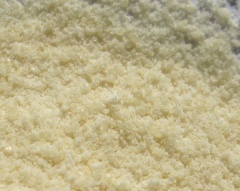Difference between revisions of "Casein"
m (→Description) |
|||
| (5 intermediate revisions by one other user not shown) | |||
| Line 1: | Line 1: | ||
| + | {{Infobox_Other_organic | ||
| + | | image = Casein.jpg | ||
| + | | origin = <ul><li>United States</li><li>Australia</li><li>Argentina</li><li>New Zealand</li><li>Poland | ||
| + | | stowage factor = <ul><li>1,84 m<sup>3</sup>/t (barrels)</li><li>1,95/2,23 m<sup>3</sup>/t (bagged casein lactic) | ||
| + | | humidity and moisture = See text | ||
| + | | ventilation = - | ||
| + | | risk factors = See text | ||
| + | }} | ||
==Description== | ==Description== | ||
| − | + | Casein is the name for a family of related phosphoproteins. These proteins are commonly found in mammalian milk, making up 80% of the proteins in cow milk and between 20% and 45% of the proteins in human milk. Casein has a wide variety of uses, viz. cheesemaking, plastic items, paper coatings, water-dispersed paints for interior use, adhesives, especially for wood laminates, textile sizing, foods and feeds, textile fibers, dietetic preparations, binder in foundry sands. <br><br> | |
| + | Commercial casein of good quality is a dry, friable, white or slightly brown powder. Casein of inferior quality has an unpleasant smell and is usually moist and dark-coloured, which may lead to believe that it has been damaged in transit.<br><br> | ||
| + | Quality depends on the nitrogen and albumen content.<br><br> | ||
| − | + | ==Shipment / Storage / Risk factors== | |
| − | + | The commodity is hygroscopic; stable when kept dry but it deteriorates rapidly when damp. | |
| + | <br><br> | ||
[[Category:Products]] | [[Category:Products]] | ||
| + | [[Category:Other organic material]] | ||
Latest revision as of 16:13, 12 January 2021
| Infobox on Casein | |
|---|---|
| Example of Casein |  |
| Facts | |
| Origin |
|
| Stowage factor (in m3/t) |
|
| Humidity / moisture | See text |
| Ventilation | - |
| Risk factors | See text |
Casein
Description
Casein is the name for a family of related phosphoproteins. These proteins are commonly found in mammalian milk, making up 80% of the proteins in cow milk and between 20% and 45% of the proteins in human milk. Casein has a wide variety of uses, viz. cheesemaking, plastic items, paper coatings, water-dispersed paints for interior use, adhesives, especially for wood laminates, textile sizing, foods and feeds, textile fibers, dietetic preparations, binder in foundry sands.
Commercial casein of good quality is a dry, friable, white or slightly brown powder. Casein of inferior quality has an unpleasant smell and is usually moist and dark-coloured, which may lead to believe that it has been damaged in transit.
Quality depends on the nitrogen and albumen content.
Shipment / Storage / Risk factors
The commodity is hygroscopic; stable when kept dry but it deteriorates rapidly when damp.











